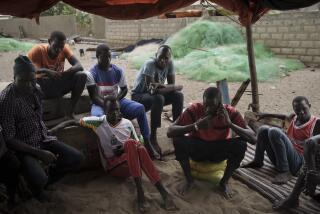As Tourists, American Blacks Return to Africa Searching to Comprehend Slavery
- Share via
GOREE ISLAND, Senegal — The freighters riding the blue-green swell in the bay these days are laden with French delicacies and champagne, but a century and a half ago, ships called at the island for a cargo of manacled Africans bound for the Americas.
This was the Slave Coast.
Tens of thousands of the ancestors of American, Brazilian, Venezuelan and Caribbean blacks--human merchandise in a once highly profitable business--were packed into ships at Goree Island near the Senegalese capital of Dakar.
It was the departure point for an 5,000-mile voyage under unspeakable conditions from West Africa to the Western Hemisphere.
These days, American blacks are retracing the ocean crossing as tourists, gazing at the 50-pound iron balls their forefathers were forced to carry as they descended into the stinking holds of the slave ships.
Goree, a flat, sandy flyspeck with white, shuttered villas and sidewalk cafes, looks like a Mediterranean holiday paradise.
For three centuries, it was one of the most important ports in Africa for the concentration of slave cargoes. The Senegalese have preserved one of many Dutch, French and Portuguese “slave houses” as a memorial to that horror.
It is a pink, two-story, stucco building overlooking the rolling Atlantic on the north side of the island. On the first floor are cramped, bare cells where the victims--chained to the solid iron balls--were imprisoned.
Beneath the imposing staircases sweeping up to the first floor balcony is the punishment hole, where offenders were often buried up to their necks in dirt.
The slave masters lived in the airy apartments above. Below, their captives were herded to ships along a narrow corridor stretching the length of the building through an arched door that opened to white surf on a pebbled beach.
For most, it was the last sight of land before the Americas weeks later.
Senegalese guides say several million Africans were shipped from the island to the United States between about 1500 and 1833 when Britain, then the world’s major sea power, banned the slave trade.
Modern historians, however, put the figure at only 400,000, attributing the large number of black slaves in the United States by 1860--4 million--to natural population increase and the import of slaves from Cuba.
But a total of about 6.3 million slaves, they say, were shipped out of Africa, the bulk to South America, where they labored throughout the Spanish and Portuguese colonies, mostly on sugar plantations.
As ships’ logs and records on Goree show, up to 30% regularly died en route, victims of disease in the squalid below-decks. Five adults would be squeezed into the equivalent area of two single beds for a journey halfway across the world.
Almost any day of the week during the U.S. holiday season, groups of black Americans can be found touring Goree Island, absorbing little-appreciated realities of the slave trade.
For example, the slavers very rarely penetrated inland to gather victims. Instead, most slaves were sold by coastal African chiefs increasingly greedy for western goods, iron and guns.
Few of the Americans said they had any idea from which exact part of Africa their ancestors were shipped to the United States. But all shared a curiosity and even sentimentality about their background.
“This is their cultural home. West Africa is where their people came from,” said Alma Molock, who works for a Philadelphia-based travel company specializing in black tours to Africa.
“No black person can ignore that,” she said.
More to Read
Sign up for Essential California
The most important California stories and recommendations in your inbox every morning.
You may occasionally receive promotional content from the Los Angeles Times.













